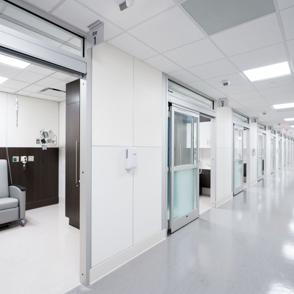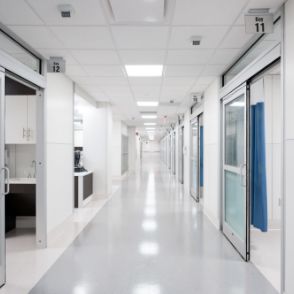Modular construction and advanced materials boost infection prevention and control in hospitals
It is hard to exaggerate the seriousness and scale of hospital acquired infections. An estimated 300,000 patients a year in England acquire an infection while receiving care within the NHS, according to the National Institute for Care and Health Excellence. In the US, the Center for Disease Control estimates there are around 1.7 million such infections and 99,000 associated deaths in American hospitals.
Hospital acquired infections not only imperil the safety of those patients who contract them but also place additional strain on NHS resources. The busier that hospitals are, the more likely it is that infections will be introduced and spread, and the more pressure will be placed on the cleaning regimes designed to prevent them. The risks of hospital acquired infections include serious respiratory conditions such as pneumonia, urinary tract infections and surgical site infections while bloodstream infections, including the headline-hitting MRSA, are also a threat.
The risks go beyond hospitals. NICE’s quality standard on Infection Prevention and Control QS61 covers people receiving healthcare in primary, community and secondary care settings including hospitals, general practices, dental clinics, health centres, care homes, schools and prisons.
Several factors increase the risks of patients acquiring infections in these situations, but inadequate cleaning is certainly one of them. NICE points out that high standards of infection prevention and control can minimise the risk. It singles out creating clean environments, and it is in that context where modular construction and advanced materials are palpably fit for purpose.
Modular Revolution
The modular construction revolution has made it possible to assemble testing pods, hospital rooms and even complete isolation suites in a fraction of the time that would be required using conventional building methods.
At Architectural Wallsz, our modular healthcare building systems are purpose-designed to be easy to clean. We embed hardware for delivering gas and other systems in the walls and bed headboards, allowing for smooth surfaces with few of the nooks and crannies where bugs can hide and dust can gather.
Crucially, the materials we use are themselves easy to clean and disinfect. There is a third benefit, too, in that modular structures can quickly be repurposed as segregation rooms to contain outbreaks
Infection Prevention Materials
The significance of materials used in healthcare settings was highlighted in a landmark article in Health Environments Research & Design Journal, which set a framework for how pathogens can spread in hospitals through air, water and contact.
Many organisms can survive on surfaces for days, weeks or even months. Several studies suggest a chain of transmission between environmental contamination and hospital acquired infections through direct or indirect contact.
Among the steps recommended to prevent transmission are:
- Set cleaning protocols
- Surfaces that resist contamination and are easily cleaned
- Physical barriers such as single-patient rooms.
An article on interior finishes and infection prevention in the US publication Health Facilities Management recommended simple design concepts such as single-patient rooms to reduce the risk of infection. It pointed out that ease of cleaning is an important consideration when choosing materials for flooring, walls, counters and other room surfaces.
The article also listed five surface characteristics to consider when selecting furnishings, which also make sense in specifying structural elements.
- Durability: Easy to maintain and repair. Torn fabrics provide a home for microorganisms and cannot be properly cleaned, as do scratched or chipped surfaces.
- Cleanability: Able to withstand cleaning and be compatible with hospital-grade detergents, cleaners and disinfectants.
- Inability to support microbial growth: Materials such as wet organic substrates (e.g. wood) that hold moisture are more likely to support microbial growth.
- Surface porosity: Microorganisms have been shown to survive on porous fabrics.
- Absence of seams: Gaps in walls, like seams in furnishings, trap bacteria and are difficult to clean.
Clearly, materials have an important role to play in ensuring healthcare structures support the fight against infections. Fortunately, modular construction for hospitals and other healthcare environments can draw on a range of advanced materials.
Here’s our quick guide to the advantages and features of each of the materials in our range.
Thermofoil: Formed from a laminate wrapped around an MDF sheet, it is durable and easily cleanable thanks to its high sheen finish and lack of gaps. Tiles can be up to 1.2 m x 3 m. Available in a wide range of colours, Thermofoil provides more variety than conventional drywall panels. It is also easier to clean, reconfigure and maintain with easy access to wall cavities.
Glass: Probably the easiest material to clean and disinfect, glass panels come in a range of types. We offer a choice of back-painted, magnetic back-painted, laminated, etched and willow glass.
Fabric: Our cleanable fabric and microperforated tile options help to reduce reverberated sounds and maintain speech privacy, noise isolation and high-fidelity sound. These materials contribute to patient wellbeing by improving acoustics without compromising infection control standards.
Extrusions: Panels are connected by extrusions. Our Enzo product has been designed for simplicity with consistent connections and with options to enable all surfaces in a modular structure to be coplanar (i.e. flush) or non-coplanar.

Regular extrusion (left) compared with flush coplanar (right)
Enzo coplanar solutions, including extrusions, wall tiles and finishes, are selected to create an infection-prevention-ready environment. This means it is set to accept healthcare infection prevention gaskets.

Frame close-ups without infection prevention gasket (left) and with gasket (right)
We developed this in response to our clients’ requests to make cleaning simpler and more effective. It’s an example of how we’re continually innovating to stay ahead of their needs.
Summary
Healthcare-associated infections arise across a wide range of clinical conditions and can affect people of all ages. They can exacerbate existing or underlying conditions, delay recovery and adversely affect quality of life. Healthcare workers, family members and carers are also at risk of acquiring infections when caring for people. Hospital acquired infections have an impact on the capacity and the reputation of the health service.
There is a clear link between pathogens living on surfaces and the spread of hospital acquired infections.
Modular hospital rooms and pods in conjunction with effective cleaning protocols make a significant contribution to minimising that risk, using materials that are easy to clean and disinfect and which reduce or eliminate the gaps where pathogens can lurk. What’s more, because modular structures can be easily and swiftly repurposed, they can quickly be turned into segregation rooms should the need arise to prevent the spread of any new outbreak.






Sorry, the comment form is closed at this time.